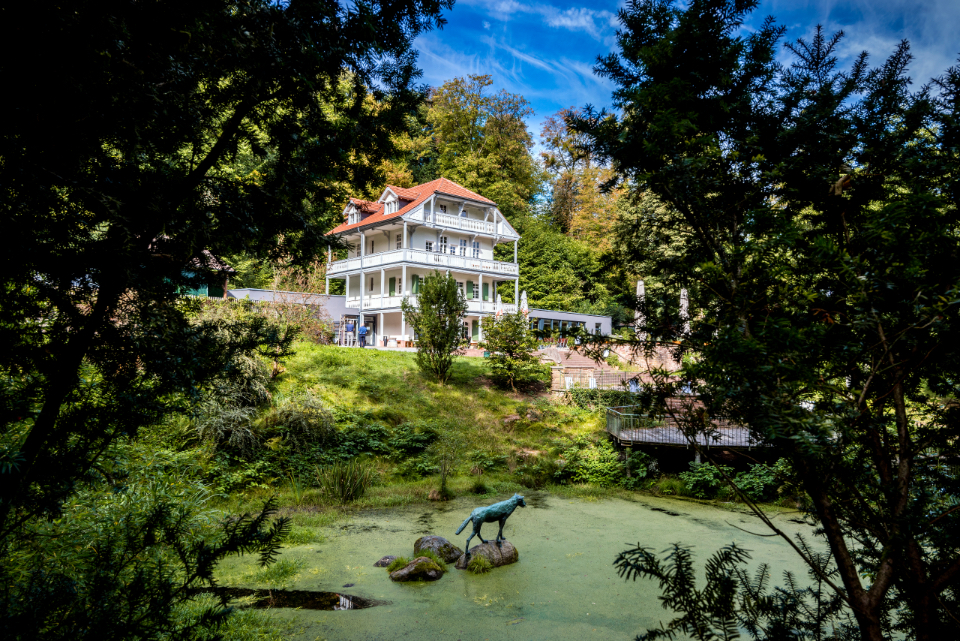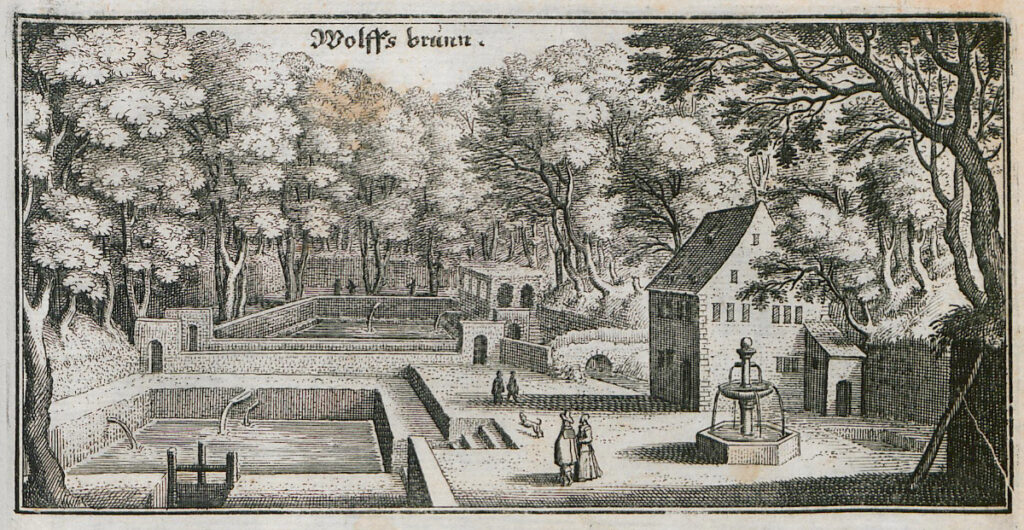 Wolfsbrunnen © tobias schwerdt
Wolfsbrunnen © tobias schwerdt The Wolfsbrunnen historic fountain in Heidelberg-Schlierbach. Located in a valley rich in springs, sloping steeply northwards from below the Königstuhl rock formation to the Neckar River and the former fishing village of Schlierbach, Elector Frederick II had a pleasure house with fountains and water features built around 1550. There were also three fish ponds there, some of which can still be seen today. The Schlierbach valley, located about two kilometers east of Heidelberg Castle, could be reached from the castle via an old high trail, today’s Schloss-Wolfsbrunnenweg. The name of the fountain probably comes from the electoral wolf hunter, who drove away and caught wolves. Several springs around the Wolfsbrunnen – e.g., the “Felsenmeerquelle” – are still used today for drinking water. The lake below the restaurant dates back to the upper of the former fish ponds.
The Wolfsbrunnen
 Wolfsbrunnen - Matthäus Merian - 1620
Wolfsbrunnen - Matthäus Merian - 1620 History
For centuries, legends and stories have surrounded the Wolfsbrunnen. The discovery of two stone axes proves that the area around the Wolfsbrunnen was already settled during the Neolithic period. The first historical reference to the site is a mention of the “House of the Wolf Hunter of the Palatinate Counts of Heidelberg” in a document from 1465. In 1550, the spring was enclosed in a well house.
In the 16th century under Prince Elector Frederick II, the Wolfsbrunnen-Anlage was constructed as a hunting and pleasure lodge. His successor, Prince Elector Frederick V, who married the English Princess Elisabeth Stuart, gave the facility a particularly romantic atmosphere, among others by constructing several trout basins. Sustained warlike conflicts throughout the 17th century and relocation of the Electoral Residence to Mannheim and Schwetzingen caused the Wolfsbrunnen-Anlage to fall into a magical slumber. Its use as a hunting lodge and inn, however, never ceased entirely.
In 1822, the house was converted into a three-story building according to plans by Weinbrenner. Its current condition is largely due to this conversion in the style of a “Swiss house.”
The Wolfsbrunnen-Anlage became a popular destination for the many Romanticists who lived in Heidelberg or visited the city, and they often expressed their enthusiasm for it in their works.The facility is also home to a diverse amphibian population in which many species are represented.
The gastronomy (Restaurant Wolfsbrunnen) was revived in 2015. Today, it offers about 50 seats and serves a small selection of high-quality seasonal dishes. The beer garden, with its city-typical hearty beer garden dishes, is particularly idyllic.
The Wolfsbrunnen-Anlage is a registered monument.
The following legend is told about the Wolfsbrunnen:
“Once, Witch Jetta, who lived on the castle hill near Heidelberg, left her home in an old chapel on a sunny day to refresh her tired spirit with a walk on the mountain. Fate guided her steps across the hills into a small valley, where a dense forest covered the mossy ground. Enchanted by the rushing water and the cool shadows, she knelt down by the spring to refresh her burning lips in the clear waves. A hungry wolf spotted her there and, suddenly bursting out of the bushes with her cubs, tore the prophetess into pieces as she raised her hands to the sky, begging in vain for rescue.”
(Badisches Sagenbuch, 1846)
